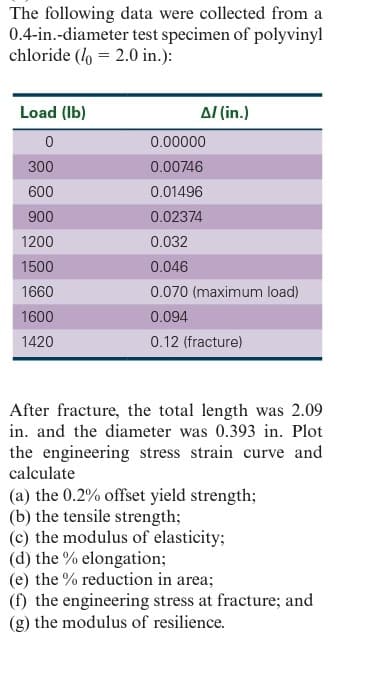The following data were collected from a 0.4-in.-diameter test specimen of polyvinyl chloride (l0 5 2.0 in.): Load (lb) 0 Δl (in.) 0.00000 300 600 900 1200 1500 1660 1600 0.00746 0.01496 0.02374 0.032 0.046 0.070 (maximum load) 0.094 1420 0.12 (fracture) After fracture, the total length was 2.09 in. and the diameter was 0.393 in. Plot the engineering stress strain curve and calculate (a) the 0.2% offset yield strength; (b) the tensile strength; (c) the modulus of elasticity; (d) the % elongation; (e) the % reduction in area; (f) the engineering stress at fracture; and (g) the modulus of resilience.
The following data were collected from a 0.4-in.-diameter test specimen of polyvinyl chloride (l0 5 2.0 in.): Load (lb) 0 Δl (in.) 0.00000 300 600 900 1200 1500 1660 1600 0.00746 0.01496 0.02374 0.032 0.046 0.070 (maximum load) 0.094 1420 0.12 (fracture) After fracture, the total length was 2.09 in. and the diameter was 0.393 in. Plot the engineering stress strain curve and calculate (a) the 0.2% offset yield strength; (b) the tensile strength; (c) the modulus of elasticity; (d) the % elongation; (e) the % reduction in area; (f) the engineering stress at fracture; and (g) the modulus of resilience.
Chapter2: Loads On Structures
Section: Chapter Questions
Problem 1P
Related questions
Question
100%
The following data were collected from a 0.4-in.-diameter test specimen of polyvinyl chloride (l0 5 2.0 in.): Load (lb) 0 Δl (in.) 0.00000 300 600 900 1200 1500 1660 1600 0.00746 0.01496 0.02374 0.032 0.046 0.070 (maximum load) 0.094 1420 0.12 (fracture) After fracture, the total length was 2.09 in. and the diameter was 0.393 in. Plot the engineering stress strain curve and calculate (a) the 0.2% offset yield strength; (b) the tensile strength; (c) the modulus of elasticity; (d) the % elongation; (e) the % reduction in area; (f) the engineering stress at fracture; and (g) the modulus of resilience.

Transcribed Image Text:The following data were collected from a
0.4-in.-diameter test specimen of polyvinyl
chloride (lo = 2.0 in.):
Load (Ib)
Al (in.)
0.00000
300
0.00746
600
0.01496
900
0.02374
1200
0.032
1500
0.046
1660
0.070 (maximum load)
1600
0.094
1420
0.12 (fracture)
After fracture, the total length was 2.09
in. and the diameter was 0.393 in. Plot
the engineering stress strain curve and
calculate
(a) the 0.2% offset yield strength;
(b) the tensile strength;
(c) the modulus of elasticity;
(d) the % elongation;
(e) the % reduction in area;
(f) the engineering stress at fracture; and
(g) the modulus of resilience.
Expert Solution
This question has been solved!
Explore an expertly crafted, step-by-step solution for a thorough understanding of key concepts.
This is a popular solution!
Trending now
This is a popular solution!
Step by step
Solved in 6 steps with 2 images

Knowledge Booster
Learn more about
Need a deep-dive on the concept behind this application? Look no further. Learn more about this topic, civil-engineering and related others by exploring similar questions and additional content below.Recommended textbooks for you


Structural Analysis (10th Edition)
Civil Engineering
ISBN:
9780134610672
Author:
Russell C. Hibbeler
Publisher:
PEARSON

Principles of Foundation Engineering (MindTap Cou…
Civil Engineering
ISBN:
9781337705028
Author:
Braja M. Das, Nagaratnam Sivakugan
Publisher:
Cengage Learning


Structural Analysis (10th Edition)
Civil Engineering
ISBN:
9780134610672
Author:
Russell C. Hibbeler
Publisher:
PEARSON

Principles of Foundation Engineering (MindTap Cou…
Civil Engineering
ISBN:
9781337705028
Author:
Braja M. Das, Nagaratnam Sivakugan
Publisher:
Cengage Learning

Fundamentals of Structural Analysis
Civil Engineering
ISBN:
9780073398006
Author:
Kenneth M. Leet Emeritus, Chia-Ming Uang, Joel Lanning
Publisher:
McGraw-Hill Education


Traffic and Highway Engineering
Civil Engineering
ISBN:
9781305156241
Author:
Garber, Nicholas J.
Publisher:
Cengage Learning